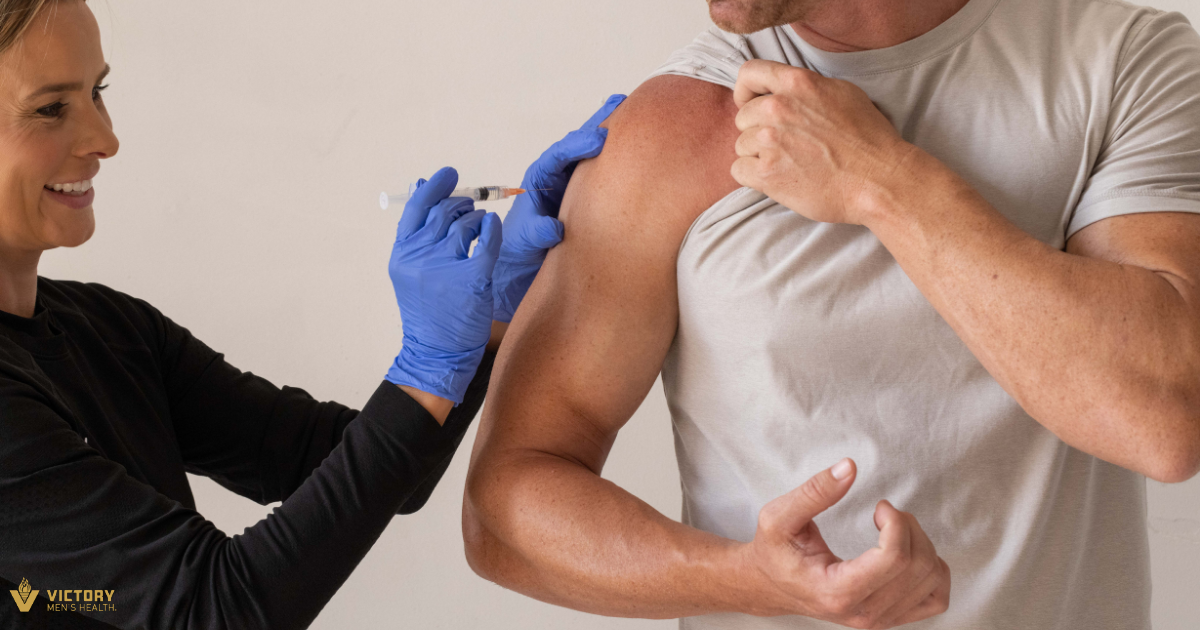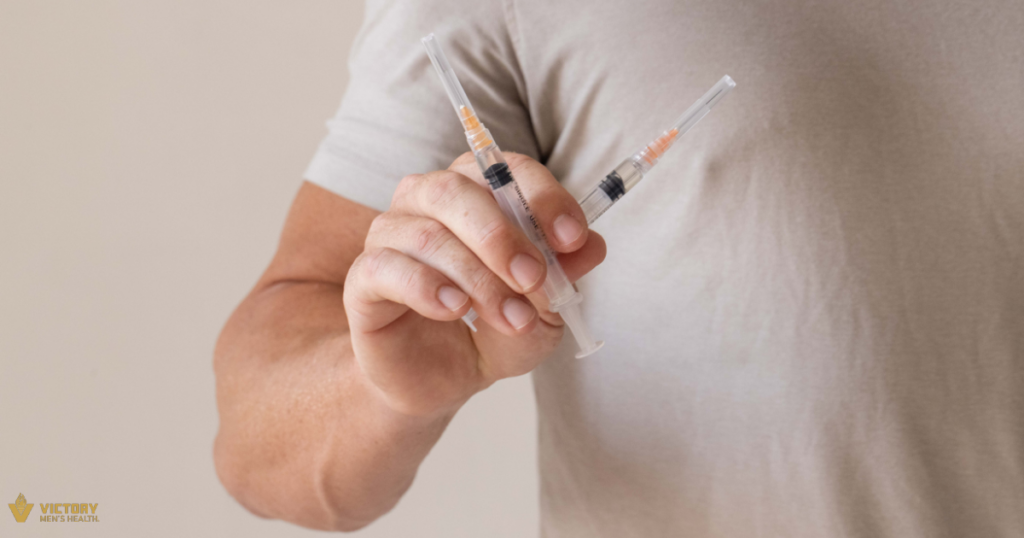TRT Dosing: How Much Testosterone Is Too Much?
category: Testosterone

If you’re on testosterone replacement therapy (TRT) or thinking about starting, it’s not unusual to wonder how much testosterone is too much. The internet is full of conflicting advice on TRT dosing, and some men assume higher doses mean better results—but that’s not how it works.
At Victory Men’s Health, we take a personalized, science-backed approach to hormone optimization. Our goal with testosterone therapy isn’t to simply raise your levels; it’s to find the right dose for your body so you can feel, perform, and live at your best.
On an episode of the Women Want Strong Men podcast, our men’s health experts answered many of the most common questions about testosterone therapy. From the proper dosage to how testosterone affects fertility and potential side effects, we covered it all. Have a listen, then head to the next section to dive into all things TRT dosing.
What is the Optimal TRT Dose?
TRT is designed to restore your testosterone levels to an optimal range, not push them into extreme territory. The “right” dose can vary from person to person based on your lab results, symptoms, metabolism, and response to treatment.
Most men start with 150 mg per week of testosterone cypionate or enanthate, split into two or more injections each week. The typical dosing range is 100-250 mg per week, but the goal is to tailor the dose based on how you feel and respond.
Factors that influence your TRT dosing include:
- Baseline testosterone levels before starting treatment
- Individual response to therapy
- Injection frequency and absorption rate
- Overall health, weight, and metabolism
Some men do well on lower doses, while others may need adjustments over time. The key is working with a knowledgeable provider who can fine-tune your treatment for the best results.
Signs You’re Taking Too Much Testosterone
More testosterone doesn’t always mean better results—especially when it’s more than your body can handle. Every man has a different threshold for how much testosterone he can tolerate, and side effects often show up when you’re taking more than your body needs. While reference ranges provide a general guide, they don’t tell the whole story.
Factors like age, lifestyle, and even decreased sensitivity at the hormone receptor site can all affect how much testosterone you actually need to feel your best. What works for your buddy might be too much for you—especially if you’re overweight, diabetic, don’t exercise, smoke, or drink regularly. Here are the common signs that you might be taking too much testosterone:
- Irritability from hormonal imbalances
- Severe acne or excessively oily skin
- Fluid retention
- Increased blood preassure
However, keep in mind that these symptoms don’t always mean your testosterone dose is too high. In some cases, improper injection frequency or fluctuations in hormone levels can be the root cause. Depending on the root cause of your symptoms, the solution may not be lowering the dose but rather adjusting the dosing strategy to maintain stable hormone levels.
Which Form of TRT is Best: Injections, Cream, or Pellets?
TRT is not a one-size-fits-all treatment. Different delivery methods impact absorption, dosing frequency, and overall effectiveness. The right option depends on your personal preference, lifestyle, and how your body responds.
At Victory Men’s Health, we start with a consultation visit and a full wellness panel with bloodwork. From there, we’ll review your test results and provide an in-depth assessment of your needs and options. We offer testosterone treatments in three forms:
1. TRT Injections
2. Transdermal Cream
3. Testosterone Pellets
TRT Injections
- The most common form of TRT
- Typically injected 1-3 times per week (intramuscular) or 3-7 times per week (subcutaneous)
- Higher peak levels and fluctuations if injected less frequently
- Can be intramuscular (IM) or subcutaneous (SubQ)
- Requires self-injection or clinic visits
- Best for men who want a consistent, reliable option and don’t mind injections
Transdermal Cream
- Applied daily or twice daily to the scrotum which has thin, vascular skin and optimizes absorption
- Avoids large fluctuations seen with injections
- No needles required
- May not absorb well in some men, although this is rare
- Must avoid accidental transference to others
- Best for men who prefer a needle-free, daily routine and want more stable hormone levels
Testosterone Pellets
- Implanted under the skin in the buttock area by a provider every 4-6 months
- Offers long-term convenience
- Difficult to adjust dosing once inserted
- Requires a quick in-office procedure, then follow-up labs after 4 weeks
- Best for men who want low-maintenance TRT and are comfortable with an in-office procedure
Each method has its pros and cons. The right choice depends on your lifestyle, tolerance for needles, and how well your body absorbs testosterone. Our health providers can help determine which option is best suited for your needs.
How to Dose TRT for the Best Results

Achieving the best results with TRT is about finding the right balance, not pushing your testosterone levels to the extreme. Proper dosing strategies help maximize benefits while avoiding unnecessary side effects. Here are some general guidelines to keep in mind:
- Splitting injections into multiple smaller doses per week helps to maintain stable levels and minimize side effects.
- Start with a conservative dose and adjust based on lab work and symptoms under the guidance of a provider. Underdosing or infrequent dosing can drop your levels lower than baseline at times, so it’s important not to undershoot.
- Consider alternative delivery methods such as transdermal testosterone (cream) or pellets, depending on your needs and preferences.
- Work with an experienced provider who understands hormone optimization for men rather than using a cookie-cutter approach to TRT.
What Happens if You Take Too Much Testosterone?
Some men assume that higher doses of testosterone will accelerate muscle growth, increase energy, or enhance performance. The truth? Too much testosterone can create problems—not solutions. Our personalized approach and progress monitoring ensure that doesn’t happen.
Taking more testosterone than your body can tolerate—especially without medical supervision—can increase the risk of side effects.
While there’s no universally established “too high” level, chronically overdosing can lead to hormonal imbalances that cause issues like sexual dysfunction, anxiety, mood swings, and sleep disturbances. These problems are more common in men who self-medicate or combine testosterone with other compounds without proper oversight.
The goal of TRT is optimization, not excess. Taking more testosterone than you need can create complications that require additional interventions to correct, which is why working with a provider specialized in men’s health and hormone optimization is essential.
Find Your Optimal TRT Dose with Victory Men’s Health
When used correctly, TRT is a powerful tool that can change your life. Success comes from consistent dosing, proper monitoring, and working with an experienced provider who understands the ins and outs of hormone optimization for men.
If you’re not sure whether your current dose is right for you, our comprehensive lab testing services can help you figure it out. When you work with our team, we’ll fine-tune your treatment plan to your unique needs and monitor your progress throughout your TRT journey.
Ready to find your optimal TRT dosing strategy? Book a consultation today to start the process of getting back to your healthiest, strongest self.